Balbharti Maharashtra State Board 11th Biology Important Questions Chapter 7 Cell Division Important Questions and Answers.
Maharashtra State Board 11th Biology Important Questions Chapter 7 Cell Division
Question 1.
Why interphase is known as the preparatory phase.
Answer:
1. During interphase, the cell is metabolically very active.
2. In this phase, a cell grows to its maximum size, chromosomal material (DNA and histone proteins) duplicates and the cell prepares itself for the next mitotic division. Hence, the interphase is known as the preparatory phase.
![]()
Question 2.
Name the following.
1. In which phase does the amount of DNA per cell doubles?
2. Which types of RNA are synthesized during first growth phase?
Answer:
1. S-phase.
2. m-RNA, t-RNA and r-RNA
Question 3.
Match the Column I (Phases of Cell cycle) with Column II (Approximate time for completion).
| Column I | Column II |
| 1. G: Phase | (a) 1-3 Hours |
| 2. Gi Phase | (b) 2-5 Hours |
| 3. M Phase | (c) 6-8 Hours |
| 4. S Phase | (d) 8 Hours |
Answer:
| Column I | Column II |
| 1. G: Phase | (b) 2-5 Hours |
| 2. Gi Phase | (d) 8 Hours |
| 3. M Phase | (a) 1-3 Hours |
| 4. S Phase | (c) 6-8 Hours |
Question 4.
What is cell division? Mention the types of cell division.
Answer:
The division of cells into two (or more) daughter cells with same (or different) genetic material is called cell division. There are three types of cell divisions:
1. Amitosis:
a. It is the simplest form of cell division. The nucleus elongates and a constriction appears along its length.
b. This constriction deepens and divides nucleus into two daughter nuclei followed by division of cytoplasm resulting in formation of two daughter cells.
c. This type of division is observed in unicellular organisms, abnormal cells, old cells and in foetal membrane cells.
2. Mitosis:
a. In this type of cell division, the cell divides and forms two similar daughter cells which are identical to the parent cell.
b. It is completed in two steps as karyokinesis and cytokinesis.
3. Meiosis:
a. In this type of cell division, the number of chromosomes is reduced to half. Hence, this type of cell division is also called reductional division.
b. Meiosis produces four haploid daughter cells from a diploid parent cell.
![]()
Question 5.
With the help of suitable diagrams, explain karyokinesis in brief.
Answer:
Karyokinesis is the nuclear division which is divided into prophase, metaphase, anaphase and telophase.
1. Prophase:
a. In this phase, condensation of chromatin material, migration of centrioles, appearance of mitotic apparatus and disappearance of nuclear membrane takes place.
b. Due to condensation, each chromosome with its sister chromatids connected by centromere is clearly visible under light microscope.
c. The nucleolus starts to disappear.
d. Centrosome start moving towards the opposite poles of the cell.
e. Mitotic apparatus is almost completely formed.
2. Metaphase:
a. Chromosomes are completely condensed and appear short.
b. Centromere and sister chromatids become very prominent.
c. All the chromosomes are arranged at equatorial plane of cell. This is called metaphase plate.
d. Mitotic spindle is fully formed in this phase.
e. Centromere of each chromosome divides horizontally into two, each being associated with a chromatid. [Note: The centromeres divide at the beginning of anaphase so that the two chromatids of each chromosome become separated from each other.
Source: Cell Division, Donald B. McMillan, Richard J. Harris, in An Atlas of Comparative Vertebrate Histology, 2018.]
3. Anaphase:
a. In this phase, chromatids of each chromosome separate and form two chromosomes called daughter chromosomes.
b. The chromosomes which are formed are pulled away in opposite direction by spindle apparatus.
c. Anaphase ends when each set of chromosomes reach at opposite poles of the cell.
4. Telophase:
a. This is the final stage of karyokinesis.
b. The chromosomes with their centromeres begin to uncoil at the poles.
c. The chromosomes lengthen and lose their individuality.
d. The nucleolus reappears and the nuclear membrane appear around the chromosomes.
e. Spindle fibres breakdown and get absorbed in the cytoplasm. Thus, two daughter nuclei are formed.
These are small disc-shaped structures at the surface of the centromeres which serve as the sites of attachment of spindle fibres to the chromosomes.
Question 6.
Draw neat and labelled diagram of Anaphase.
Answer:
Anaphase:
a. In this phase, chromatids of each chromosome separate and form two chromosomes called daughter chromosomes.
b. The chromosomes which are formed are pulled away in opposite direction by spindle apparatus.
c. Anaphase ends when each set of chromosomes reach at opposite poles of the cell.
![]()
Question 7.
Match the following.
| Column I | Column II |
| 1. Prophase | (a) Chromatids moving to opposite poles. |
| 2. Metaphase | (b) Nuclear membrane starts disappearing. |
| 3. Anaphase | (c) Chromosomes at equatorial plane of the cell. |
| 4. Telophase | (d) Nuclear membrane reappears |
Answer:
| Column I | Column II |
| 1. Prophase | (b) Nuclear membrane starts disappearing. |
| 2. Metaphase | (c) Chromosomes at equatorial plane of the cell. |
| 3. Anaphase | (a) Chromatids moving to opposite poles. |
| 4. Telophase | (d) Nuclear membrane reappears |
Question 8.
Observe the given diagram and explain the depicted process in your own words.
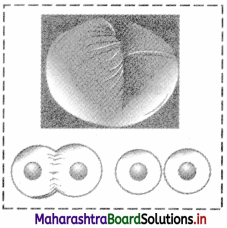
Answer:
- The process depicted in the given diagram is cytokinesis in animal cell.
- This step takes place at the end of karyokinesis (nuclear division) of mitosis.
- It depicts the division of the cytoplasmic material in order to form two daughter cells that resemble each other.
- The division starts with a constriction generally at the equator. This constriction gradually deepens and ultimately joins in the centre dividing into two cells.
- At the time of cytoplasmic division, organelles like mitochondria and plastids get distributed between the two daughter cells.
![]()
Question 9.
Diagrammatically differentiate between cytokinesis in animal cell and plant cell.
Answer:

Question 10.
How cell wall is formed in plant cell?
Answer:
The formation of the new cell wall begins with the formation of a simple precursor, called the ‘cell-plate’ that represents the middle lamella between the walls of two adjacent cells.
Question 11.
What is necrosis?
Answer:
Necrosis is a form of cell injury which leads to the premature death of cells. For example: due to scrape or a harmful chemical.
Question 12.
What is apoptosis? Write its significance.
Answer:
- Apoptosis also known as programmed cell death or cellular suicide. In apoptosis cells die in controlled way.
- For example: during embryonic development the cells between the embryonic fingers die in a normal process called apoptosis to give a definite shape to the fingers.
- Apoptosis also helps in eliminating potential cancer cells.
![]()
Question 13.
Which type of cell division is known as reductional division? Why?
Answer:
1. Meiosis is known as reductional division.
2. The number of chromosome is reduced to half, hence, meiosis is known as reductional division.
Question 14.
Describe the various phases of heterotypic division.
Answer:
Heterotypic division is first meiotic division, during which a diploid cell is divided into two haploid cells. The daughter cells resulting from this division are different from the parent cell in chromosome number. Hence the division is called heterotypic division.
It consists of following phases:
1. Prophase -I:
It is the most complicated and longest phase of meiotic division.
It is further divided into five sub-phases viz. leptotene, zygotene, pachytene, diplotene and diakinesis.
a. Leptotene:
- The volume of the nucleus increases.
- The chromosomes become long distinct and coiled.
- They orient themselves in a specific fonn known as bouquet stage. This is characterized with the ends of chromosomes converged towards the side of nucleus where the centrosome lies.
- The centriole duplicates into two and migrates to opposite poles. [Note: Centrioles divide during Gj phase of interphase.]
b. Zygotene:
- Pairing of non-sister chromatids of homologous chromosomes takes place by formation of synaptonemal complex. This pairing is called synapsis.
- Each pair consists of a maternal chromosome and a paternal chromosome. Chromosomal pairs are called bivalents or tetrads.
c. Pachytene:
- Each individual chromosome begins to split longitudinally into two similar chromatids. Therefore, each bivalent now appears as a tetrad consisting of four chromatids.
- The homologous chromosomes begin to separate but they do not separate completely and remain attached to one or more points. These points are called chiasmata (Appear like a cross-X).
- Chromatids break at these points and broken segments are exchanged between non-sister chromatids of homologous chromosomes resulting in recombination.
d. Diplotene:
The chiasma becomes clearly visible in diplotene due to beginning of repulsion between synapsed homologous chromosomes. This is known as desynapsis. Synaptonemal complex also starts to disappear.
e. Diakinesis:
- The chiasmata begin to move along the length of chromosomes from the centromere towards the ends of chromosomes. The displacement of chiasmata is termed as terminalization.
- The terminal chiasmata exist till the metaphase.
- The nucleolus and nuclear membrane completely disappear and spindle fibres begin to appear.
2. Metaphase -1:
a. The spindle fibres are well developed.
b. The tetrads orient themselves on equator in such a way that centromeres of homologous tetrads lie towards the poles and arms towards the equator.
c. They are ready to separate as repulsive force increases.
a. Homologous chromosomes are carried towards the opposite poles by spindle apparatus. This is known as disjunction.
b. The two sister chromatids of each chromosome do not separate in meiosis -I. This is reductional division.
c. The sister chromatids of each chromosome are connected by a common centromere.
d. Both sister chromatids of each chromosome are now different in genetic content as one of them has undergone recombination.

3. Anaphase – I:
1. Homologous chromosomes are carried towards the opposite poles by spindle apparatus. This is known as disjunction.
2. The two sister chromatids of each chromosome do not separate in meiosis -I. This is reductional division.
3. The sister chromatids of each chromosome are connected by a common centromere.
4. Both sister chromatids of each chromosome are now different in genetic content as one of them has undergone recombination.
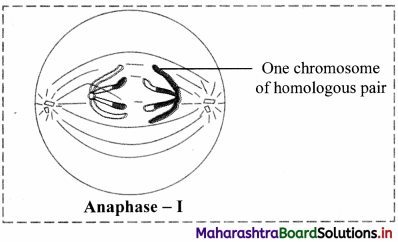
4. Telophase-I:
a. The haploid number of chromosomes becomes uncoiled and elongated after reaching their respective poles.
b. The nuclear membrane and nucleolus reappear and thus two daughter nuclei are formed.
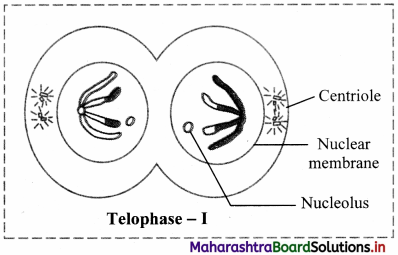
Cytokinesis -1:
Cytokinesis occurs after karyokinesis and two haploid cells are formed. In many cases, these daughter cells pass through interkinesis.
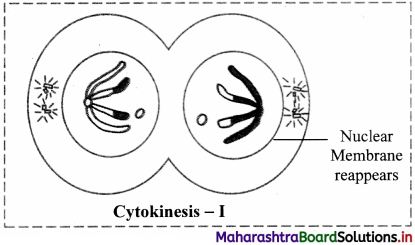
[Note: The association between the homologous chromosomes i.e. chiasmata remain till metaphase I. During metaphase /, the paired homologous chromosomes move to the metaphase plate. In anaphase [ the spindle fibers begin to shorten. As these spindle fibres shorten, the association between homologous chromosomes (chiasmata) are broken, allowing homologous chromosomes to be pulled to opposite poles.]
![]()
Question 15.
What is Homotypic Division? Explain its phases.
Answer:
Two haploid cells formed during first meiotic division divide further into four haploid cells this division is called homotypic division. It consists of five phases: prophase – II, metaphase – II, anaphase – II, telophase – II, and Cytokinesis – II.
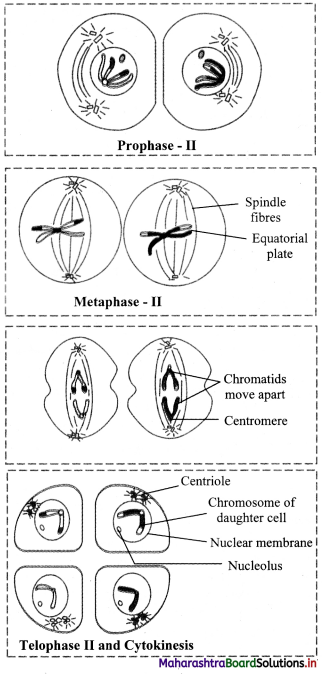
1. Prophase-II:
a. The chromosomes are distinct with two chromatids.
b. Each centriole divides into two resulting in formation of two centrioles which migrate to opposite poles and form asters.
c. Spindle fibres are formed between the centrioles.
d. The nuclear membrane and nucleolus disappears in this phase.
2. Metaphase -II:
a. Chromosomes are arranged at the equator.
b. The two chromatids of each chromosome are separated by division of the centromere.
c. Some of the spindle fibres are attached to the centromeres and some are arranged end to end between two opposite centrioles.
3. Anaphase – II:
In this phase, the separated chromatids become daughter chromosomes and move to opposite poles due to the contraction of the spindle fibres attached to centromeres.
4. Telophase – II:
a. In this stage daughter chromosomes starts to uncoil.
b. The nuclear membrane surrounds each group of chromosomes.
c. Nucleolus reappears in this phase.
5. Cytokinesis – II
a. Cytokinesis takes place after the nuclear division.
b. Two haploid cells are formed from each haploid cell.
c. Thus, four haploid daughter cells are formed.
d. These cells then undergo changes to form gametes.
![]()
Question 16.
Why meiosis is important?
Answer:
- Meiotic division produces gametes or spores.
- If it is absent, the number of chromosomes would double or quadruple resulting in the formation of monstrosities (abnormal gametes).
- The constant number of chromosomes in a given species across generations is maintained by meiosis and fertilization.
- Because of crossing over, exchange of genetic material takes place leading to genetic variations, which are the raw materials for evolution.
Question 17.
Observe the diagram and answer the questions given below it.
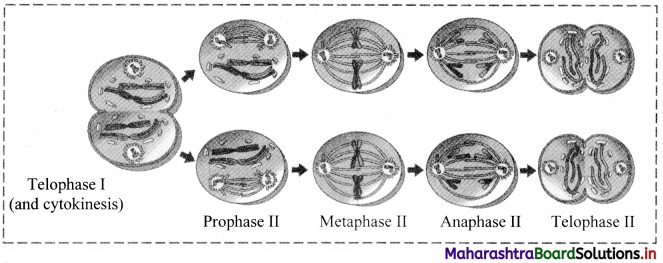
1. Identify the type of cell division shown in the diagram.
2. Write its significance of meiosis.
Answer:
1. The type of cell division shown in diagram is meiosis II.
2. Meiotic division produces gametes or spores.
- If it is absent, the number of chromosomes would double or quadruple resulting in the formation of monstrosities (abnormal gametes).
- The constant number of chromosomes in a given species across generations is maintained by meiosis and fertilization.
- Because of crossing over, exchange of genetic material takes place leading to genetic variations, which are the raw materials for evolution.
Question 18.
Explain Anaphase-I with a neat labelled diagram.
Answer:
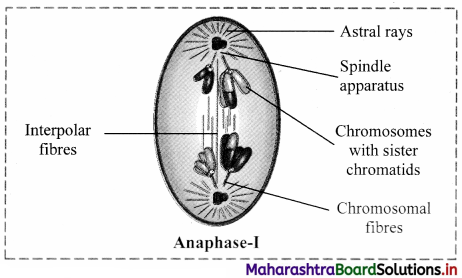
Anaphase:
a. In this phase, chromatids of each chromosome separate and form two chromosomes called daughter chromosomes.
b. The chromosomes which are formed are pulled away in opposite direction by spindle apparatus.
c. Anaphase ends when each set of chromosomes reach at opposite poles of the cell.
Question 19.
What is crossing over? Give its significance.
Answer:
Crossing over:
The process of exchange of genetic material between non-sister chromatids of homologous chromosomes is known as crossing over.
Significance of crossing over:
Crossing over results in genetic recombination of parental characters that leads to variations.
![]()
Question 20.
What happens during diakinesis?
Answer:
- In diakinesis, the chiasmata begin to move along the length of chromosomes from the centromere towards the ends of chromosomes.
- The displacement of chiasmata is termed as terminalization. The terminal chiasmata exist till the metaphase.
- The nucleolus disappears and the nuclear membrane also begins to disappear.
- Spindle fibres starts to appear in the cytoplasm.
Question 21.
Differentiate between anaphase of mitosis and anaphase – I of meiosis.
Answer:
| Anaphase of mitosis | Anaphase – I of meiosis |
| 1. Centromere divides into two, resulting in the separation of chromatids. | Centromere does not divide. |
| 2. Homologous chromosomes are not involved. | Homologous chromosomes are involved. |
| 3. Disjunction does not occur. | Disjunction occurs. |
| 4. Same number of chromosomes gather at each pole. | Half the chromosome number gather at respective pole. |
Question 22.
Give reasons: Meiosis is known as reductional division.
Answer:
Meiosis is known as reductional division because the parent cell produces four daughter cells each having half the number of chromosomes present in the parent cell.
Question 23.
Fill in the blanks:
- The process of mitosis maintains the _______.
- ________ involves the cell death, but it benefits the organism as a whole.
- Crossing over takes place in _______ phase of Prophase-I.
Answer:
- The process of mitosis maintains the nucleo-cytoplasmic ratio.
- Apoptosis involves the cell death, but it benefits the organism as a whole.
- Crossing over takes place in pachytene phase of Prophase-I.
Question 24.
1. Complete the following flowchart.
2. Explain the type of cell division in which chromosome number remain the same as that of the parent cell.
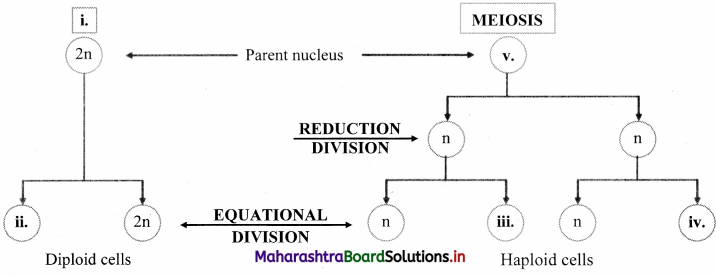
Answer:
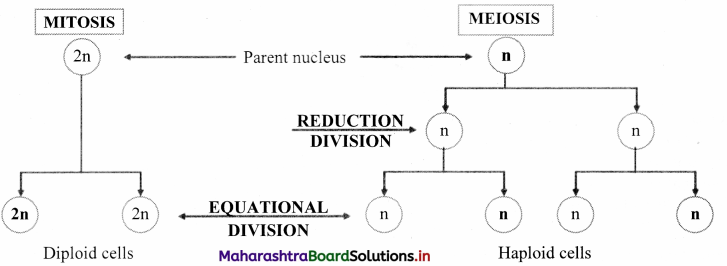 Karyokinesis is the nuclear division which is divided into prophase, metaphase, anaphase and telophase.
Karyokinesis is the nuclear division which is divided into prophase, metaphase, anaphase and telophase.
1. Prophase:
a. In this phase, condensation of chromatin material, migration of centrioles, appearance of mitotic apparatus and disappearance of nuclear membrane takes place.
b. Due to condensation, each chromosome with its sister chromatids connected by centromere is clearly visible under light microscope.
c. The nucleolus starts to disappear.
d. Centrosome start moving towards the opposite poles of the cell.
e. Mitotic apparatus is almost completely formed.
2. Metaphase:
a. Chromosomes are completely condensed and appear short.
b. Centromere and sister chromatids become very prominent.
c. All the chromosomes are arranged at equatorial plane of cell. This is called metaphase plate.
d. Mitotic spindle is fully formed in this phase.
e. Centromere of each chromosome divides horizontally into two, each being associated with a chromatid. [Note: The centromeres divide at the beginning of anaphase so that the two chromatids of each chromosome become separated from each other.
Source: Cell Division, Donald B. McMillan, Richard J. Harris, in An Atlas of Comparative Vertebrate Histology, 2018.]
3. Anaphase:
a. In this phase, chromatids of each chromosome separate and form two chromosomes called daughter chromosomes.
b. The chromosomes which are formed are pulled away in opposite direction by spindle apparatus.
c. Anaphase ends when each set of chromosomes reach at opposite poles of the cell.
4. Telophase:
a. This is the final stage of karyokinesis.
b. The chromosomes with their centromeres begin to uncoil at the poles.
c. The chromosomes lengthen and lose their individuality.
d. The nucleolus reappears and the nuclear membrane appear around the chromosomes.
e. Spindle fibres breakdown and get absorbed in the cytoplasm. Thus, two daughter nuclei are formed.
These are small disc-shaped structures at the surface of the centromeres which serve as the sites of attachment of spindle fibres to the chromosomes.
![]()
Question 25.
While studying mitosis, different teams of students made following observations in the cells focused under microscope.
1. In certain cells chromosomes were arranged at equatorial plane with fibres originating from cylindrical structures at both the poles.
2. Few cells showed chromatids moving towards opposite poles.
a. In first observation which stage of mitosis is seen by students and what is the scientific term used to represent cylindrical structures?
b. Which stage is seen in the second observation?
Answer:
a. The stage observed in the first case is metaphase. The scientific term used to represent the cylindrical structures are centrioles.
b. The other stage seen in second observation is anaphase.
Question 26.
During biology practical students were asked to see the slide mounted under microscope and note down their observations. Few students noted that the stage observed is anaphase of mitosis and others said that it is anaphase I of meiosis. Later while explaining about experiments teacher said that it is anaphase I of meiosis. On what basis teacher confirmed that it is anaphase I of meiosis?
Answer:
Chromosomes moving towards opposite poles during anaphase I do not separate at the centromeres.
Question 27.
Colchicine is an alkaloid extracted from plants. It prevents the formation of spindle fibres. In the presence colchicine, if a cell enters mitosis what would be the outcome?
Answer:
The spindle fibres are necessary for segregating the sister chromatids to opposite poles of the cell during anaphase. In the presence of colchicine, no spindle fibres will form to attach to the kinetochores (small disc¬like structures present on chromosomes). Therefore, the cell will be stuck in mitosis with the condensed pairs of sister chromatids in an unorganized array.
Question 28.
Read the following statements and mention whether they are TRUE or FALSE in respective boxes.
1. Life of all multicellular organisms starts from single cell which is known as zygote.
2. Spindle fibres present between centriole and centromere are known as polar fibres which can contract.
3. Growth of every living organism depends on cell division.
4. Spindle fibres present between opposite centrioles are called as kinetochore fibres which can elongate.
| (i) | (ii) | (iii) | (iv) | |
| (A) | T | T | F | T |
| (B) | F | F | T | F |
| (C) | T | F | T | F |
| (D) | 1 | T | F | F ‘ |
Answer:
(C)
![]()
Question 29.
Quick Review
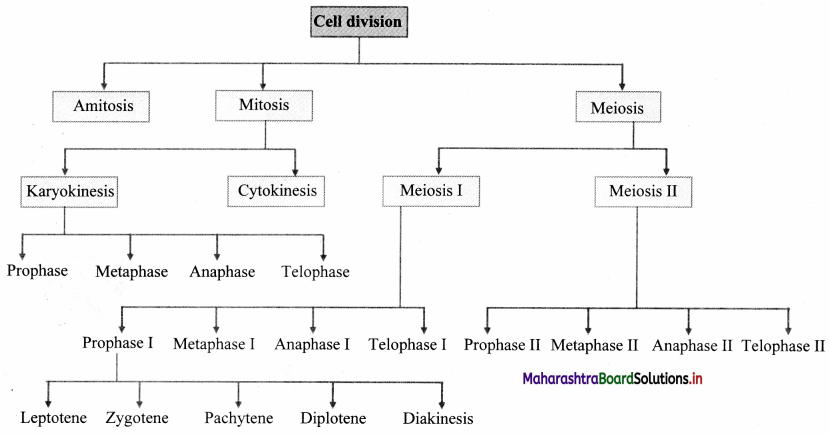
Question 30.
Exercise:
Question 1.
Define cell cycle.
Answer:
- Sequential events occurring in the life of a cell is called cell cycle.
- Interphase and M – phase are the two phases of cell cycle.
- Cell undergoes growth or rest during interphase and divides during M – phase.
Question 2.
Observe the following diagram and the questions based on it.
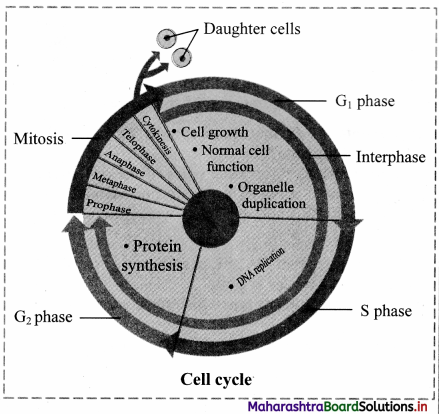
1. If the initial amount of DNA in a cell is 2C then in which phase of cell cycle the amount of this DNA would become 4C? Also name the process.
2. Which sub-phase of the interphase is of short duration?
3. Enlist the phases of karyokinesis in proper order.
Answer:
S – phase (Synthesis phase):
In this phase DNA is synthesized (replicated), so that amount of DNA per cell doubles.
Synthesis of histone proteins takes place in this phase.
Karyokinesis is the nuclear division which is divided into prophase, metaphase, anaphase and telophase.
1. Prophase:
a. In this phase, condensation of chromatin material, migration of centrioles, appearance of mitotic apparatus and disappearance of nuclear membrane takes place.
b. Due to condensation, each chromosome with its sister chromatids connected by centromere is clearly visible under light microscope.
c. The nucleolus starts to disappear.
d. Centrosome start moving towards the opposite poles of the cell.
e. Mitotic apparatus is almost completely formed.
2. Metaphase:
a. Chromosomes are completely condensed and appear short.
b. Centromere and sister chromatids become very prominent.
c. All the chromosomes are arranged at equatorial plane of cell. This is called metaphase plate.
d. Mitotic spindle is fully formed in this phase.
e. Centromere of each chromosome divides horizontally into two, each being associated with a chromatid. [Note: The centromeres divide at the beginning of anaphase so that the two chromatids of each chromosome become separated from each other.
Source: Cell Division, Donald B. McMillan, Richard J. Harris, in An Atlas of Comparative Vertebrate Histology, 2018.]
3. Anaphase:
a. In this phase, chromatids of each chromosome separate and form two chromosomes called daughter chromosomes.
b. The chromosomes which are formed are pulled away in opposite direction by spindle apparatus.
c. Anaphase ends when each set of chromosomes reach at opposite poles of the cell.
4. Telophase:
a. This is the final stage of karyokinesis.
b. The chromosomes with their centromeres begin to uncoil at the poles.
c. The chromosomes lengthen and lose their individuality.
d. The nucleolus reappears and the nuclear membrane appear around the chromosomes.
e. Spindle fibres breakdown and get absorbed in the cytoplasm. Thus, two daughter nuclei are formed.
These are small disc-shaped structures at the surface of the centromeres which serve as the sites of attachment of spindle fibres to the chromosomes.
![]()
Question 3.
During which stage of Prophase-I synapsis occurs?
Answer:
b. Zygotene:
Pairing of non-sister chromatids of homologous chromosomes takes place by formation of synaptonemal complex. This pairing is called synapsis.
Each pair consists of a maternal chromosome and a paternal chromosome. Chromosomal pairs are called bivalents or tetrads.
Question 4.
During which stage disjunction takes place?
Answer:
Telophase-I:
a. The haploid number of chromosomes becomes uncoiled and elongated after reaching their respective poles.
b. The nuclear membrane and nucleolus reappear and thus two daughter nuclei are formed.
Question 5.
What is disjunction?
Answer:
Telophase-I:
a. The haploid number of chromosomes becomes uncoiled and elongated after reaching their respective poles.
b. The nuclear membrane and nucleolus reappear and thus two daughter nuclei are formed.
Question 6.
Why meiosis is known as reductional division?
Answer:
In this type of cell division, the number of chromosomes is reduced to half. Hence, this type of cell division is also called reductional division.
Question 7.
Sketch and label the phase of cell division in which synaptonemal complex is formed?
Answer:
Zygotene:
Pairing of non-sister chromatids of homologous chromosomes takes place by formation of synaptonemal complex. This pairing is called synapsis.
Each pair consists of a maternal chromosome and a paternal chromosome. Chromosomal pairs are called bivalents or tetrads.
![]()
Question 8.
Make a schematic representation of a type of cell division in which chromosome number is reduced to half.
Answer:
Karyokinesis is the nuclear division which is divided into prophase, metaphase, anaphase and telophase.
1. Prophase:
a. In this phase, condensation of chromatin material, migration of centrioles, appearance of mitotic apparatus and disappearance of nuclear membrane takes place.
b. Due to condensation, each chromosome with its sister chromatids connected by centromere is clearly visible under light microscope.
c. The nucleolus starts to disappear.
d. Centrosome start moving towards the opposite poles of the cell.
e. Mitotic apparatus is almost completely formed.
2. Metaphase:
a. Chromosomes are completely condensed and appear short.
b. Centromere and sister chromatids become very prominent.
c. All the chromosomes are arranged at equatorial plane of cell. This is called metaphase plate.
d. Mitotic spindle is fully formed in this phase.
e. Centromere of each chromosome divides horizontally into two, each being associated with a chromatid. [Note: The centromeres divide at the beginning of anaphase so that the two chromatids of each chromosome become separated from each other.
Source: Cell Division, Donald B. McMillan, Richard J. Harris, in An Atlas of Comparative Vertebrate Histology, 2018.]
3. Anaphase:
a. In this phase, chromatids of each chromosome separate and form two chromosomes called daughter chromosomes.
b. The chromosomes which are formed are pulled away in opposite direction by spindle apparatus.
c. Anaphase ends when each set of chromosomes reach at opposite poles of the cell.
4. Telophase:
a. This is the final stage of karyokinesis.
b. The chromosomes with their centromeres begin to uncoil at the poles.
c. The chromosomes lengthen and lose their individuality.
d. The nucleolus reappears and the nuclear membrane appear around the chromosomes.
e. Spindle fibres breakdown and get absorbed in the cytoplasm. Thus, two daughter nuclei are formed.
These are small disc-shaped structures at the surface of the centromeres which serve as the sites of attachment of spindle fibres to the chromosomes.
Question 9.
Describe mitosis and its stages in brief.
Answer:
Karyokinesis is the nuclear division which is divided into prophase, metaphase, anaphase and telophase.
1. Prophase:
a. In this phase, condensation of chromatin material, migration of centrioles, appearance of mitotic apparatus and disappearance of nuclear membrane takes place.
b. Due to condensation, each chromosome with its sister chromatids connected by centromere is clearly visible under light microscope.
c. The nucleolus starts to disappear.
d. Centrosome start moving towards the opposite poles of the cell.
e. Mitotic apparatus is almost completely formed.
2. Metaphase:
a. Chromosomes are completely condensed and appear short.
b. Centromere and sister chromatids become very prominent.
c. All the chromosomes are arranged at equatorial plane of cell. This is called metaphase plate.
d. Mitotic spindle is fully formed in this phase.
e. Centromere of each chromosome divides horizontally into two, each being associated with a chromatid. [Note: The centromeres divide at the beginning of anaphase so that the two chromatids of each chromosome become separated from each other.
Source: Cell Division, Donald B. McMillan, Richard J. Harris, in An Atlas of Comparative Vertebrate Histology, 2018.]
3. Anaphase:
a. In this phase, chromatids of each chromosome separate and form two chromosomes called daughter chromosomes.
b. The chromosomes which are formed are pulled away in opposite direction by spindle apparatus.
c. Anaphase ends when each set of chromosomes reach at opposite poles of the cell.
4. Telophase:
a. This is the final stage of karyokinesis.
b. The chromosomes with their centromeres begin to uncoil at the poles.
c. The chromosomes lengthen and lose their individuality.
d. The nucleolus reappears and the nuclear membrane appear around the chromosomes.
e. Spindle fibres breakdown and get absorbed in the cytoplasm. Thus, two daughter nuclei are formed.
These are small disc-shaped structures at the surface of the centromeres which serve as the sites of attachment of spindle fibres to the chromosomes.
![]()
Question 10.
Describe chiasmata. Draw diagram to illustrate your answer.
Answer:
Pachytene:
Each individual chromosome begins to split longitudinally into two similar chromatids. Therefore, each bivalent now appears as a tetrad consisting of four chromatids.
The homologous chromosomes begin to separate but they do not separate completely and remain attached to one or more points. These points are called chiasmata (Appear like a cross-X).
Chromatids break at these points and broken segments are exchanged between non-sister chromatids of homologous chromosomes resulting in recombination.
Diplotene:
The chiasma becomes clearly visible in diplotene due to beginning of repulsion between synapsed homologous chromosomes. This is known as desynapsis. Synaptonemal complex also starts to disappear.
Question 11.
Correct the following diagram and write a short note on it.
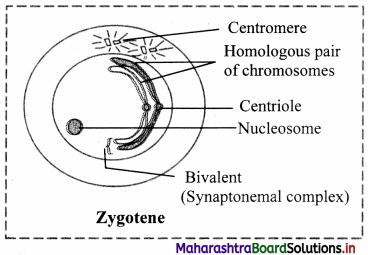
Answer:
b. Zygotene:
Pairing of non-sister chromatids of homologous chromosomes takes place by formation of synaptonemal complex. This pairing is called synapsis.
Each pair consists of a maternal chromosome and a paternal chromosome. Chromosomal pairs are called bivalents or tetrads.
Question 12.
Explain prophase I in your own words.
Answer:
Prophase -I:
It is the most complicated and longest phase of meiotic division.
It is further divided into five sub-phases viz. leptotene, zygotene, pachytene, diplotene and diakinesis.
Question 13.
Explain homotypic division.
Answer:
Two haploid cells formed during first meiotic division divide further into four haploid cells this division is called homotypic division. It consists of five phases: prophase – II, metaphase – II, anaphase – II, telophase – II, and Cytokinesis – II.
1. Prophase-II:
a. The chromosomes are distinct with two chromatids.
b. Each centriole divides into two resulting in formation of two centrioles which migrate to opposite poles and form asters.
c. Spindle fibres are formed between the centrioles.
d. The nuclear membrane and nucleolus disappears in this phase.
2. Metaphase -II:
a. Chromosomes are arranged at the equator.
b. The two chromatids of each chromosome are separated by division of the centromere.
c. Some of the spindle fibres are attached to the centromeres and some are arranged end to end between two opposite centrioles.
3. Anaphase – II:
In this phase, the separated chromatids become daughter chromosomes and move to opposite poles due to the contraction of the spindle fibres attached to centromeres.
4. Telophase – II:
a. In this stage daughter chromosomes starts to uncoil.
b. The nuclear membrane surrounds each group of chromosomes.
c. Nucleolus reappears in this phase.
5. Cytokinesis – II
a. Cytokinesis takes place after the nuclear division.
b. Two haploid cells are formed from each haploid cell.
c. Thus, four haploid daughter cells are formed.
d. These cells then undergo changes to form gametes.
![]()
Question 14.
How does cytokinesis in plant cells differ from animal cells?
Answer:
The formation of the new cell wall begins with the formation of a simple precursor, called the ‘cell-plate’ that represents the middle lamella between the walls of two adjacent cells.
Question 15.
What is the significance of meiosis in sexually reproducing animals?
Answer:
- Meiotic division produces gametes or spores.
- If it is absent, the number of chromosomes would double or quadruple resulting in the formation of monstrosities (abnormal gametes).
- The constant number of chromosomes in a given species across generations is maintained by meiosis and fertilization.
- Because of crossing over, exchange of genetic material takes place leading to genetic variations, which are the raw materials for evolution.
- Gametes are produced by the process of meiosis which are essential for sexual reproduction.
- Diploid organisms have two set of chromosomes (one paternal and one maternal).
- For a diploid organism to undergo sexual reproduction it needs to create gametes that contain only one set of chromosomes so the number of chromosomes remains same in the next generation.
- In absence of meiosis, the chromosome number of parents and their offsprings will differ in every generation; hence no species will hold its characters.
- Also, there will be no crossing over of homologous chromosomes. Thus, there will be no variations with respect to the changing environment in progeny to maintain their existence, which may lead to extinction of species.
Question 16.
Explain the first three stages of Meiosis II.
Answer:
Two haploid cells formed during first meiotic division divide further into four haploid cells this division is called homotypic division. It consists of five phases: prophase – II, metaphase – II, anaphase – II, telophase – II, and Cytokinesis – II.
1. Prophase-II:
a. The chromosomes are distinct with two chromatids.
b. Each centriole divides into two resulting in formation of two centrioles which migrate to opposite poles and form asters.
c. Spindle fibres are formed between the centrioles.
d. The nuclear membrane and nucleolus disappears in this phase.
2. Metaphase -II:
a. Chromosomes are arranged at the equator.
b. The two chromatids of each chromosome are separated by division of the centromere.
c. Some of the spindle fibres are attached to the centromeres and some are arranged end to end between two opposite centrioles.
3. Anaphase – II:
In this phase, the separated chromatids become daughter chromosomes and move to opposite poles due to the contraction of the spindle fibres attached to centromeres.
4. Telophase – II:
a. In this stage daughter chromosomes starts to uncoil.
b. The nuclear membrane surrounds each group of chromosomes.
c. Nucleolus reappears in this phase.
5. Cytokinesis – II
a. Cytokinesis takes place after the nuclear division.
b. Two haploid cells are formed from each haploid cell.
c. Thus, four haploid daughter cells are formed.
d. These cells then undergo changes to form gametes.
![]()
Question 17.
Sketch, label and describe telophase in mitosis.
Answer:
Telophase:
a. This is the final stage of karyokinesis.
b. The chromosomes with their centromeres begin to uncoil at the poles.
c. The chromosomes lengthen and lose their individuality.
d. The nucleolus reappears and the nuclear membrane appear around the chromosomes.
e. Spindle fibres breakdown and get absorbed in the cytoplasm. Thus, two daughter nuclei are formed.
These are small disc-shaped structures at the surface of the centromeres which serve as the sites of attachment of spindle fibres to the chromosomes.
Question 18.
Explain the process recombination.
Answer:
a. Recombination is exchange of genetic material between paternal and maternal chromosomes during gamete formation.
b. The points where crossing over takes place is known as chiasmata.
c. Chromatids acquire new combinations of alleles by physically exchanging segments in crossing-over.
d. The exchange of genetic material between homologous chromosomes involves accurate breakage and joining of DNA molecules through a complex mechanism.
e. It is catalyzed by enzymes.
Question 19.
1. What is necrosis?
2. What is apoptosis? Mention its significance.
Answer:
1. Necrosis is a form of cell injury which leads to the premature death of cells. For example: due to scrape or a harmful chemical.
(2) 1. Apoptosis also known as programmed cell death or cellular suicide. In apoptosis cells die in controlled way.
2. For example: during embryonic development the cells between the embryonic fingers die in a normal process called apoptosis to give a definite shape to the fingers.
3. Apoptosis also helps in eliminating potential cancer cells.
Question 20.
Multiple Choice Questions:
Question 1.
Replication of DNA takes place during
(A) prophase
(B) S-phase
(C) G2 phase
(D) Interkinesis
Answer:
(B) S-phase
Question 2.
During cell division, spindle fibers are attached to
(A) telomere
(B) centromere
(C) chromomeres
(D) chromosome
Answer:
(B) centromere
Question 3.
Which of the following is the shortest phase?
(A) metaphase
(B) anaphase
(C) interphase
(D) S-phase
Answer:
(B) anaphase
Question 4.
Reappearance of nucleolus is during
(A) telophase
(B) prophase
(C) cytokinesis
(D) inter-kinesis
Answer:
(A) telophase
![]()
Question 5.
During telophase,
(A) nuclear membrane is formed.
(B) nucleolus appears.
(C) astral rays disappear.
(D) all the above
Answer:
(D) all the above
Question 6.
Cytokinesis in plant cell takes place by
(A) furrowing
(B) cell plate formation
(C) any one of (A) or (B)
(D) none of these
Answer:
(B) cell plate formation
Question 7.
Meiosis is a
(A) homotypic division
(B) equatorial division
(C) reductional division
(D) none of the above
Answer:
(C) reductional division
Question 8.
Formation of Synaptonemal complex during meiosis occurs at
(A) Leptotene
(B) Zygotene
(C) Diplotene
(D) Pachytene
Answer:
(B) Zygotene
Question 9.
Crossing over takes place in the ________ stage.
(A) leptotene
(B) zygotene
(C) pachytene
(D) diplotene
Answer:
(C) pachytene
![]()
Question 10.
Crossing over takes place between
(A) sister chromatids
(B) non-homologous chromosomes
(C) non-sister chromatids of homologues
(D) any two chromatids
Answer:
(C) non-sister chromatids of homologues
Question 11.
Crossing over of chromosomes during meiosis leads to
(A) mutation
(B) sex determination
(C) new gene combination
(D) loss of chromosomes
Answer:
(C) new gene combination
Question 12.
Points at which crossing over has taken place between homologous chromosomes are called
(A) chiasmata
(B) synaptonemal complexes
(C) centromeres
(D) telomere
Answer:
(A) chiasmata
Question 13.
Which of the following events take place during diplotene stage of prophase I of meiosis?
(A) Compaction of chromosomes
(B) Formation of synapsis
(C) Process of crossing over
(D) Repulsion of homologues
Answer:
(D) Repulsion of homologues
Question 14.
The correct sequence of stages in prophase I of meiosis is
(A) Leptotene, Pachytene, Zygotene, Diakinesis, Diplotene
(B) Zygotene, Leptotene, Pachytene, Diakinesis, Diplotene
(C) Leptotene, Zygotene, Pachytene, Diplotene, Diakinesis
(D) Diplotene, Diakinesis, Pachytene, Zygotene, Leptotene
Answer:
(C) Leptotene, Zygotene, Pachytene, Diplotene, Diakinesis
Question 15.
In which phase of meiosis are homologous chromosomes separated?
(A) Anaphase I
(B) Prophase II
(C) Anaphase II
(D) Prophase I
Answer:
(A) Anaphase I
![]()
Question 16.
Mitosis differs from meiosis in not having
(A) Long prophase
(B) duplication of DNA
(C) Synapsis and crossing over
(D) interphase
Answer:
(C) Synapsis and crossing over
Question 17.
How many divisions are required to produce 128 gametes?
(A) 64
(B) 16
(C) 32
(D) 12
Answer:
(C) 32
Question 18.
Number of cells undergoing meiotic divisions to produce 124 microspores in angiosperm is
(A) 62
(B) 31
(C) 124
(D) 8
Answer:
(B) 31
Question 19.
How many haploid daughter cells are produced at the end of meiosis-II?
(A) 2
(B) 4
(C) 6
(D) 8
Answer:
(B) 4
Question 21.
Competitive Corner:
Question 1.
Crossing over takes place between which chromatids and in which stage of the cell cycle?
(A) Non-sister chromatids of nonhomologous chromosomes at Pachytene stage of prophase I
(B) Non-sister chromatids of nonhomologous chromosomes at Zygotene stage of prophase I
(C) Non-sister chromatids of homologous chromosomes at Pachytene stage of prophase I
(D) Non-sister chromatids of homologous chromosomes at Zygotene stage of prophase I
Answer:
(C) Non-sister chromatids of homologous chromosomes at Pachytene stage of prophase I
![]()
Question 2.
After meiosis I, the resultant daughter cells have
(A) four times the amount of DNA in comparison to haploid gamete.
(B) same amount of DNA as in the parent cell in S phase.
(C) twice the amount of DNA in comparison to haploid gamete.
(D) same amount of DNA in comparison to haploid gamete.
Answer:
(C) twice the amount of DNA in comparison to haploid gamete.
Question 3.
Cells in G0 phase
(A) suspend the cell cycle
(B) terminate the cell cycle
(C) exit the cell cycle
(D) enter the cell cycle
Answer:
(C) exit the cell cycle
Question 4.
The CORRECT sequence of phases of cell cycle is: [NEET (UG) 2019]
(A) S → G1 → G2 → M
(B) G1 → S → G2 → M
(C) M → G1 → G2 → S
(D) G1 → G2 → S → M
Answer:
(B) G1 → S → G2 → M
Question 5.
The stage during which separation of the paired homologous chromosomes begins is
(A) Diakinesis
(B) Diplotene
(C) Pachytene
(D) Zygotene
Answer:
(B) Diplotene
Question 6.
Which of the following options gives the correct sequence of events during mitosis?
(A) Condensation → nuclear membrane disassembly → crossing over – segregation → telophase
(B) Condensation → nuclear membrane disassembly → arrangement at equator → centromere division → segregation → telophase
(C) Condensation → crossing over → nuclear membrane disassembly → segregation → telophase
(D) Condensation → arrangement at equator → centromere division → segregation → telophase
Answer:
(B) Condensation → nuclear membrane disassembly → arrangement at equator → centromere division → segregation → telophase
Question 7.
Which of the following is not a characteristic feature during mitosis in somatic cells?
(A) Chromosome movement
(B) Synapsis
(C) Spindle fibres
(D) Disappearance of nucleolus
Answer:
(B) Synapsis
![]()
Question 8.
Arrange the following events of meiosis in correct sequence. [AIPMT Retest 2015]
(a) Crossing over
(b) Synapsis
(c) Terminalisation of chiasmata
(d) Disappearance of nucleolus
(A) (b), (c), (d), (a)
(B) (b), (a), (d), (c)
(C) (b),(a), (c), (d)
(D) (a), (b), (c), (d)
Answer:
(C) (b),(a), (c), (d)